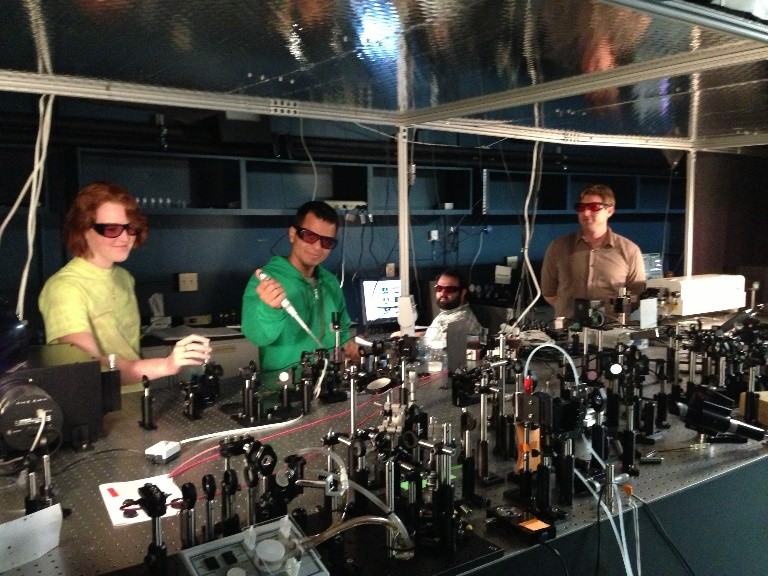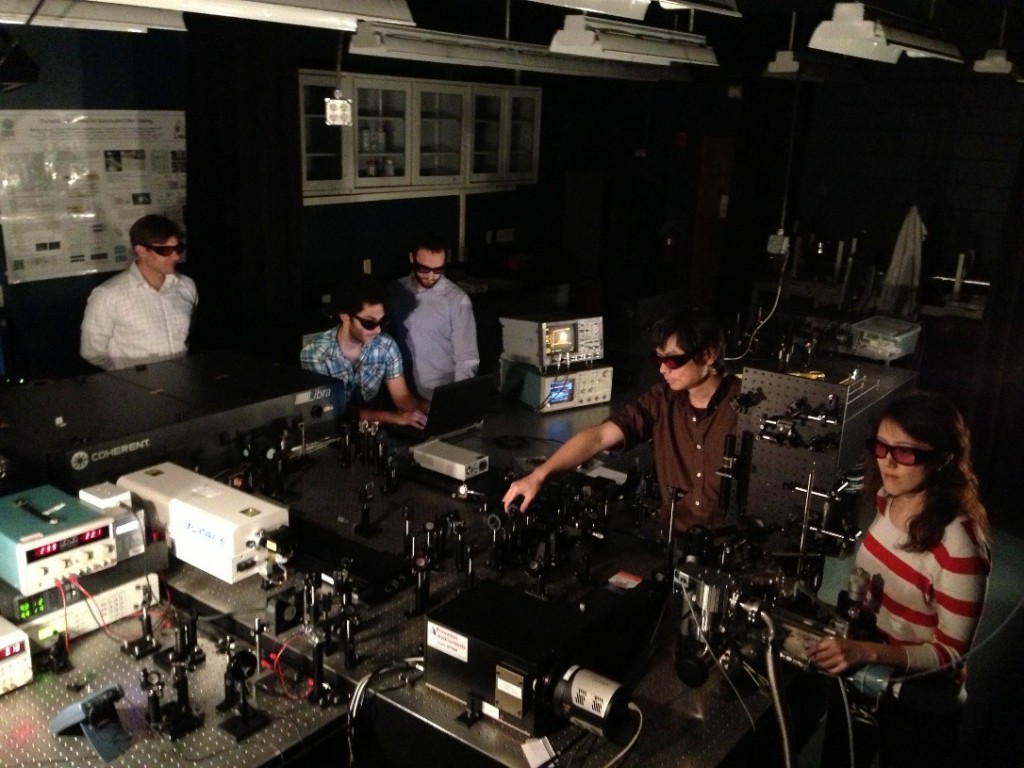Research
 Research at the Haber Group at the Department of Chemistry at Louisiana State University
in Baton Rouge focuses on fundamental investigations of nanoparticles and nanomaterials
and their interactions with molecules and light. Our research group uses ultrafast
spectroscopy and nonlinear spectroscopy, such as time-resolved second harmonic generation
(SHG), sum-frequency generation (SFG), and transient absorption (TA) to study processes
such as molecular adsorption, molecular structure and orientation, and energy and
electron transfer at nanoparticle surfaces, either supported on substrates or in colloidal
suspension. We are particularly interested in surface plasmon resonances of metallic
nanoparticles, characterized by the coherent oscillations of free electrons under
incident light, which provide large optical field enhancements while altering the
excited-state energies and relaxation dynamics of nearby molecules. Additionally,
our research focuses on potential advances in applications of molecular sensing, nanomedicine,
catalysis, and solar energy.
Research at the Haber Group at the Department of Chemistry at Louisiana State University
in Baton Rouge focuses on fundamental investigations of nanoparticles and nanomaterials
and their interactions with molecules and light. Our research group uses ultrafast
spectroscopy and nonlinear spectroscopy, such as time-resolved second harmonic generation
(SHG), sum-frequency generation (SFG), and transient absorption (TA) to study processes
such as molecular adsorption, molecular structure and orientation, and energy and
electron transfer at nanoparticle surfaces, either supported on substrates or in colloidal
suspension. We are particularly interested in surface plasmon resonances of metallic
nanoparticles, characterized by the coherent oscillations of free electrons under
incident light, which provide large optical field enhancements while altering the
excited-state energies and relaxation dynamics of nearby molecules. Additionally,
our research focuses on potential advances in applications of molecular sensing, nanomedicine,
catalysis, and solar energy.
We utilize ultrafast and nonlinear spectroscopy to study the optical and molecular interactions with nanoparticles and nanomaterials. One of our recent publications reports on the molecular adsorption and spectroscopy of different dye molecules at colloidal gold nanoparticle surfaces. Using the surface-specific technique of second harmonic generation, the adsorption isotherms of the triphenylmethane dyes malachite green, brilliant green, and methyl green were measured and the influence of the chemical changes were observed to dramatically influence the free energies of absorption and the adsorbate site densities on the gold nanoparticle surface in water. The spectral interactions between the molecules and the plasmonic gold nanoparticles were also carefully analyzed to obtain new insights on plamonic resonant coupling through polaritons, which has important implications for molecular sensing applications.

 Additional work has studied other molecular, optical, and physical interactions involving
nanoparticle surfaces using advanced spectroscopic techniques. In a recently submitted
paper, we have determined the surface charge density of small gold nanoparticles using
second harmonic generation for the first time. In another recently submitted paper,
we have investigated energy transfer and excited-state relaxation dynamics of nanoparticles
composed of organic salts using transient absorption for developing new nanomaterials
that are promising candidates for increasing photovoltaic efficiencies. We have ongoing
studies on biologically-relevant plasmonic nanoparticles for photothermal cancer therapy
and drug delivery using SHG and TA. We are also investigating photocatalysis on nanomaterials
through pump-probe vibrational sum-frequency generation spectroscopy experiments.
Using ultrafast and nonlinear spectroscopic techniques, our research group provides
fundamental measurements on molecular interactions with different types of nanoparticles
and nanomaterials for advanced applications in molecular sensing, nanomedicine, catalysis,
and solar energy.
Additional work has studied other molecular, optical, and physical interactions involving
nanoparticle surfaces using advanced spectroscopic techniques. In a recently submitted
paper, we have determined the surface charge density of small gold nanoparticles using
second harmonic generation for the first time. In another recently submitted paper,
we have investigated energy transfer and excited-state relaxation dynamics of nanoparticles
composed of organic salts using transient absorption for developing new nanomaterials
that are promising candidates for increasing photovoltaic efficiencies. We have ongoing
studies on biologically-relevant plasmonic nanoparticles for photothermal cancer therapy
and drug delivery using SHG and TA. We are also investigating photocatalysis on nanomaterials
through pump-probe vibrational sum-frequency generation spectroscopy experiments.
Using ultrafast and nonlinear spectroscopic techniques, our research group provides
fundamental measurements on molecular interactions with different types of nanoparticles
and nanomaterials for advanced applications in molecular sensing, nanomedicine, catalysis,
and solar energy.